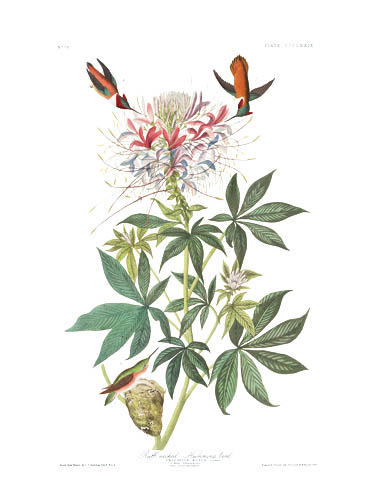|
Havell Name
Ruff-necked Humming-bird Common Name Ruff-necked Humming-bird Havell Plate No. 379 Paper Size 39" x 28" Image Size 18" x 11" Price $ 600 |
||||
|
Ornithological Biography This charming Humming-bird was discovered by the great navigator, Captain Cook, who found it abundant at Nootka Sound. It does not appear to have been seen by Dr. RICHARDSON or Mr. DRUMMOND in the northern parts of America, traversed by those most zealous and highly talented naturalists. As no account has hitherto been given of its habits, the following notices from my friends Mr. NUTTALL and Mr. TOWNSEND, will, I doubt not, prove highly interesting. ŌĆ£We began,ŌĆØ says the first of these enterprising travellers, ŌĆ£to meet with this species near the Blue Mountains of the Columbia river, in the autumn, as we proceeded to the west. These were all young birds, and were not very easily distinguished from those of the common species of the same age. We now for the first time (April 16) saw the males in numbers, darting, burring, and squeaking in the usual manner of their tribe; but when engaged in collecting its accustomed sweets in all the energy of life, it seemed like a breathing gem, or magic carbuncle of glowing fire, stretching out its gorgeous ruff, as if to emulate the sun itself in splendour. Towards the close of May, the females were sitting, at which time the males were uncommonly quarrelsome and vigilant, darting out at me as I approached the tree probably near the nest, looking like an angry coal of brilliant fire, passing within very little distance of my face, returning several times to the attack, sinking and darting with the utmost velocity, at the same time uttering a curious reverberating sharp bleat, somewhat similar to the quivering twang of a dead twig, yet also so much like the real bleat of some small quadruped, that for some time I searched the ground instead of the air, for the actor in the scene. At other times, the males were seen darting up high in the air, and whirling about each other in great anger, and with much velocity. After these manoeuvres the aggressor returned to the same dead twig, where for days he regularly took his station with all the courage and angry vigilance of a King-bird. The angry hissing or bleating note of this species seems something like wht ŌĆśt ŌĆśt ŌĆśt ŌĆśt sh vee, tremulously uttered as it whirls and sweeps through the air, like a musket-ball, accompanied also by something like the whirr of the Night-hawk. On the 29th of May, I found a nest of this species in a forked branch of the Nootka Bramble, Rubus Nutkanus. The female was sitting on two eggs, of the same shape and colour as those of the common species. The nest also was perfectly similar, but somewhat deeper. As I approached, the female came hovering round the nest, and soon after, when all was still, she resumed her place contentedly.ŌĆØ Mr. TOWNSENDŌĆÖs note is as follows:--ŌĆØNootka Sound Humming-bird, Trochilus rufus, Ah-puets-Rinne of the Chinooks. On a clear day the male may be seen to rise to a great height in the air, and descend instantly near the earth, then mount again to the same altitude as at first, performing in the evolution the half of a large circle. During the descent it emits a strange and astonishingly loud note, which can be compared to nothing but the rubbing together of the limbs of trees during a high wind. I heard this singular note repeatedly last spring and summer, but did not then discover to what it belonged. I did not suppose it to be a bird at all, and least of all a Humming-bird. The observer thinks it almost impossible that so small a creature can be capable of producing so much sound. I have never observed this habit upon a dull or cloudy day.ŌĆØ Mr. NUTTALL having presented me with the nest of this species attached to the twig to which the bird had fastened it, my amiable friend Miss MARTIN has figured it for me, as well as the plant, about which these lovely creatures are represented. The nest, which measures two inches and a quarter in height, and an inch and three quarters in breadth, at the upper part, is composed externally of mosses, lichens, and a few feathers, with slender fibrous roots interwoven, and lined with fine cottony seed-down. TROCHILUS RUFUS, Gmel. Syst. Nat., vol. i. p. 497. TROCHILUS (SELASPHORUS) RUFUS, Cinnamon or Nootka Humming-bird, Swains. and Rich. F. Bor. Amer., vol. ii. p. 324. RUFFED-NECKED HUMMING-BIRD, Trochilus rufus, Aud. Orn. Biog., vol. iv.p. 555. Male, 3 7/12, wing, 1 (7 1/4)/12. From California along the north-west coast to Nootka Sound. Abundant. Migratory. |
|||||
|
|
|||||


| Home | Gallery | Audubon Biography | About Edition | Testimonials | Authorized Dealers | Links | Contact Us |

© Copyright 2007-2025 Zebra Publishing, LLC. | All Rights Reserved Terms of Use
Powered by Fusedog Media Group
